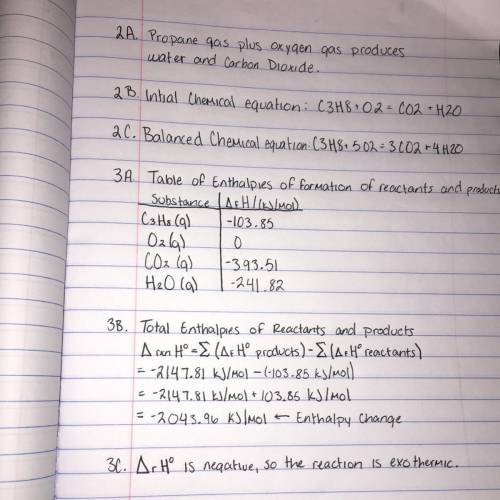
Chemistry, 09.02.2021 20:50 GreenHerbz206
Please help! The picture is what I have so far, I just need help with steps 4 and 5.
Step 4: Model the energy change in the reaction.
a) Create an energy graph that illustrates the energy change in the reaction.
b) Construct your graph on a blank sheet of paper. Be sure to label the axes, provide a title, and
identify the reactants and products on the graph.
Step 5: Explain the energy change in the reaction.
a) Create a new blank document. Type your name at the top.
b) Write a few paragraphs describing the chemical reaction and explaining the energy change in
the reaction. Your document should:
i. identify the reactants and products.
ii. describe the change in energy that occurs as bonds are broken and formed.
iii. identify how the potential energy of the reactants compares to the potential energy of
the products.
iv. state and explain the net change in enthalpy.
v. identify whether the reaction is endothermic or exothermic.
vi explain how energy is conserved between the reaction and the surrounding
environment.


Answers: 1


Other questions on the subject: Chemistry

Chemistry, 22.06.2019 04:30, ajsoccer1705
Using the periodic table, complete the table to describe each atom. type in your answers
Answers: 3

Chemistry, 22.06.2019 05:30, MansellS5529
A3.37-mg sample of protein was chemically digested to convert its nitrogen into ammonia and then diluted to 100.0 ml. then 10.0 ml of this solution was placed in a 50-ml volumetric flask and treated with 5 ml of phenol solution plus 2 ml of sodium hypochlorite solution. the sample was diluted to 50.0 ml, and the absorbance at 625 nm was measured in a 1.00-cm cuvette and found to be 0.486. for reference, a standard solution was prepared from 10.0 mg of nh4cl (molar mass = 53.49 grams/mole) dissolved in 1.00 l of water. then 10.0 ml of this standard was placed in a 50-ml volumetric flask, treated in the same manner as the unknown, and the absorbance found to be 0.323. finally, a reagent blank was prepared using distilled water in place of unknown, it was treated in the same manner as the unknown, and the absorbance found to be 0.076. calculate the weight percent of nitrogen in the protein.
Answers: 1

Chemistry, 22.06.2019 22:40, hannahkharel2
Maleic acid is a carbon-hydrogen-oxygen compound used in dyeing and finishing fabrics and as a preservative of oils and fats.* in a combustion analysis, a 1.054-g sample of maleic acid yields 1.599 g of co_2 and 0.327 g of h2o.* when 0.609 g of maleic acid is dissolved in 25.00 g of glacial acetic acid, the freezing point drops by 0.82 c. maleic acid does not ionize in glacial acetic acid, which has a freezing-point depression constant of k_{\rm f}=3.90~^\circ {\rm c}/m.* in a titration experiment, a 0.4250- g sample of maleic acid is dissolved in water and requires 34.03 ml of 0.2152 m koh for its complete neutralization.* the ph of 0.215 g of maleic acid in 50.00 ml of aqueous solution is found to be 1.80.part adetermine the empirical formula for maleic acid. enter the atoms in order ofc, h, and o. part bdetermine the molecular formula for maleic acid. enter the atoms in order of c, h, and o. express your answer as a chemical formula. part cbased on the titration data, how many ionizable h atoms are in each molecule of maleic acid, c4h4o4? express your answer as an integer. i got the part a and b which is cho and c4h4o4 respectively, can anyone me for part c? the below is what i have so far from other qa'sfinding the empirical formula for maleic acid, needs this info"a combustion analysis a 1.054-g sample of maleic acid yields 1.599g of and 0.327g of ".the rest of your data is used to find molar mass, molecular formula, equivalent mass, # of h+ ions / molecule & katypically this should be: a 1.054-g sample of maleic acid yields 1.599g of co2 and 0.327g of h2osofind mass using molar masses1.599g of co2 @ (12.01 g carbon) / (44.01 g co2) = 0.436 grams of carbon0.327g of h2o @ (2.016 g hydrogen) / (18.01 g/mol h2o) = 0.037 grams of hydrogen1.054-g sample - 0.436 grams of carbon - 0.037 grams of hydrogen = 0.581 grams of oxygennow use molar masses to find moles0.436 grams of carbon @ 12.01 g/mol = 0.0363 mol c0.037 grams of hydrogen @ 1.008 g/mol = 0.0367 mol h0.581 grams of oxygen @ 16.00 g/mol = 0.0363 mol oyour empirical formula ischo and molecular is c4h4o4
Answers: 3

Chemistry, 23.06.2019 03:10, mani1682
Which of the following compounds would be expected to have the strongest ionic bonds? a)the compound that has b)the largest ions with the greatest charge c)the compound that has d)the largest ions with the least charge the compound that has the smallest ions with the greatest charge the compound that has the smallest ions with the least charge
Answers: 2
You know the right answer?
Please help! The picture is what I have so far, I just need help with steps 4 and 5.
Step 4: Model...
Questions in other subjects:

Mathematics, 31.07.2020 22:01





Health, 31.07.2020 22:01

History, 31.07.2020 22:01


Social Studies, 31.07.2020 22:01



